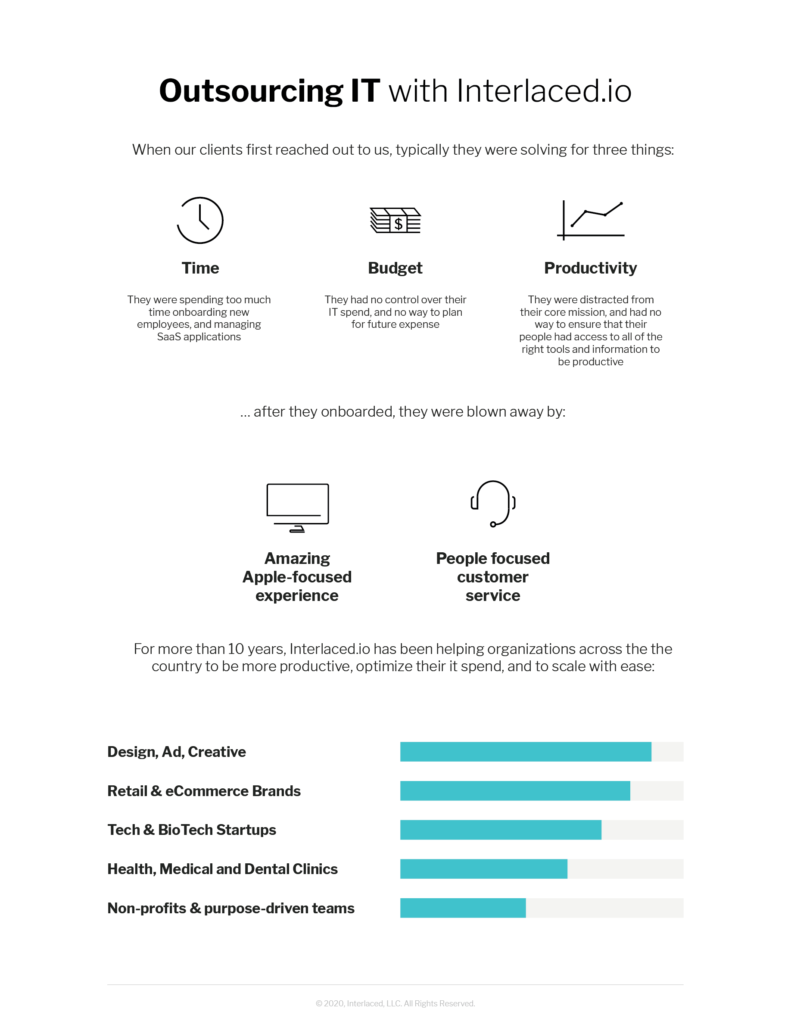For most companies, the role of technology has become even more clear, as a result of recent events. Additionally, the reliance on technology will only increase, as teams get back to work (having to do more with less) as they repair and rebuild in the coming months. Teams need their technology to work at all times, and they need someone to call when they have issues. Depending on the situation, companies may hire employees to handle IT in-house, they may use their staff (technical or not) to manage their IT program, or they may outsource IT to a third-party provider.
When does it make sense to hire IT, and when does it make sense to outsource? Does it ever make sense to scrappily manage your IT program yourself?

Benefits of Outsourcing IT
Before you can decide whether outsourcing is right for you, you must first understand the reasons a business might choose this path. Below are some of the potential benefits of outsourcing IT:
- Fewer headaches – When you outsource IT, you no longer have to worry about maintenance, upgrades, repairs, or any other technological problems.
- Fewer expenses – Outsourcing IT is cost-effective, as you won’t have to pay for full-time employees to handle IT. The costs of hiring, training, benefits, and more add up.
- Scalability – Outsourced IT services can be scaled up or down to meet your needs as your company evolves.
- Team of support — When you outsource your IT, you’re gaining access to a team of professionals. You will no longer be dependant on one person or small team, you’ll have a multitude of experts to help minimize downtime and improve efficiency.
- Better use of in-house resources – Many businesses delegate IT responsibilities to existing employees when they can’t afford to hire full-time IT personnel. With outsourcing, you will no longer need to split your employees’ focus in this way.
Downsides of Outsourcing
Although outsourcing IT offers several benefits, there can be downsides as well. For example, you won’t have as much control over your operations as you would have if you kept IT in-house. You’ll be entrusting core functions, possibly even security, to a third-party. And this third-party might not hold the same standards that you would as a company. Most MSPs offer sound infrastructure and experienced staff, but just like everything in life, there are also less-qualified companies out there. In addition, if your provider is in a different time zone or has a heavy workload, communication can be problematic.
By taking the time to find the right provider, you can mitigate many of these risks, but it’s important to understand them when deciding to outsource or not.
Should You Outsource?
Deciding whether to outsource IT to a third-party provider can be a challenge for any company. It’s a decision that each organization must consider for their specific goals and needs. And there are many factors to contemplate.
If you aren’t sure whether outsourcing IT is right for your company, simply compare your options and weigh the pros and cons. Remember to evaluate the potential for cost savings, as well as the impact on your day-to-day operations. It’s also a good idea to learn about the services available to you so you will know what you should expect if you choose to outsource.
If you decide to proceed with outsourcing, it is important to consider multiple providers before making a selection. Choosing the right IT provider can make all the difference in the success of your company. Remember that the cost of outsourced services is not the most important factor. Making sure that you are receiving reliable, high-quality services is essential.
Interview each of the providers you are considering. Ask them about the services they provide, the fees they charge (does their business model align with your needs?), and the customer support they offer. You should also read reviews from past customers. This way you can find out how others have felt about the services they received from the provider in question.
In Conclusion
There is no right or wrong answer when it comes to choosing between outsourcing and going the in-house route. If you’re looking to lower costs or take some IT needs off you or your employees’ plates, outsourcing might be the better option for you. But if you want to have complete control over your technology infrastructure, hiring in-house is probably the best fit. And, you can always combine the two. You can hire a Chief Technology Officer or IT department in-house and then also outsource for backup and additional support.
